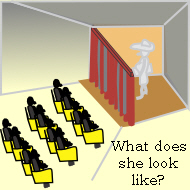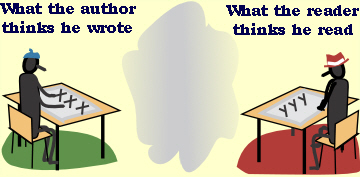|
Number 67 — January 13, 2006
Story Analysis — Part 5
· Previous · INDEX · Next ·
I divided Act 2 into four scenes. The first deals with the interviews conducted by Assistant Inspector Grimes. The purpose is to provide the reader with the background information from boarding the plane until his arrival. Miss Callas is present, but does not take part in this scene. Since she is the POV character throughout the story, I did not use any internalization until she returns in the next scene.
After the first writing of the story, I felt it needed more energy and so I introduced Ulrich Bremen for the sole purpose of needling Grimes. He has no role relative to the story problem; a subject I will address later.
The second scene of Act 2 begins when Grimes says, "Okay, Miss Callas, you're at bat. Did you know the man in 22B?" After six short lines of dialogue, I return to internalization. Marisa sees the first signs of relief and looks ahead to the end of the ordeal. Grimes challenges her, followed by a paragraph of internalization in which the reader learns Marisa and her father scripted the performance, and Marisa goes into her speech. Then comes the surprise to those in the interview room and hopefully, to the reader, too; Otto is her husband.
Let's backtrack to examine if that is a realistic plot point and why her father would not be aware of the marriage. Early in the first scene, I wrote; At twenty-one Lucia owned a TV, a refrigerator, a washing machine, new clothes, and rented a three-room flat, leaving her father alone to grovel in his misery. This shows her separation, implying it is because of her disrespect for her father. Later, I introduced this line: They lived apart in civil discord, each tending their own affairs. This is to reinforce the idea of their separation. I wrote: One day he realized Lucia held the key. It was she who brought Otto de la Fuentes into their lives …. At this point in the story I, as author, know Marisa and Otto are not married, and I doubt if any reader suspects they will be. I wrote: Throughout the next year, Edmundo incubated his plan, … . This fixes a time element. Marisa marries six months before they carry out the crime, leaving the inference she engineered the marriage, keeping it secret from her father after she knew about the forthcoming crime. If the reader feels it would be impossible for her father not to know about her marriage, I provided a pathway back through the story to show in the author's view, it is possible. Whether the reader will make the connection—or will even ask the question—is another matter.
Act 2 Scene 3, shows Marisa in the washroom where I introduce more internalization to complete the crime plan for the benefit of the reader. The last scene is the telephone call to her father where she double-crosses him, making him aware she told the insurance company about his fraudulent application. She construes this as her alibi and the reader sees her as the duplicitous character she is.
Is the story finished? May I sell it for publication somewhere? I don't think so. Why? Because I committed a fatal error: I failed to visualize the crucial event before I started. Did it make a difference. Absolutely.
Editing Note: The following postscript did not appear in the original Internet series.
In writing the analysis of the Phoenix story, I arrived at the crucial scene where Miss Pollack accompanies Marisa from the interview, resulting in exposure of her duplicity. Throughout these articles, I have emphasized the benefit of thinking through the crucial scene before beginning to write. Had I done that, surely I would have realized that Lucia, having two aliases and one of them married, would not work. In the story as written, Marisa defeats herself when she departs from her father's plan and reveals her marriage. Her intent is to double cross her father, but she fails. If Grimes does not notice the name problem during the interview, he will the next day when he gets the passenger list. Thus, Marisa's ad lib leads to her downfall and the ending, as written, is wrong and I can expect a rejection slip if I send it to an editor.
Return to Article 61 where I wrote short snippets of three possible story lines. In none of them did I develop a crucial scene. When I made my selection, I should have stopped at that point to develop my plan in detail. My point is had I thought through the crucial scene before I began, the error would not have occurred in the first place. Suppose, instead of a short story, I had written a full length novel, only to discover a year or so after I started, I had made an avoidable mistake had I taken more time at the outset to complete my story plan.
· Previous · INDEX · Next ·
|

